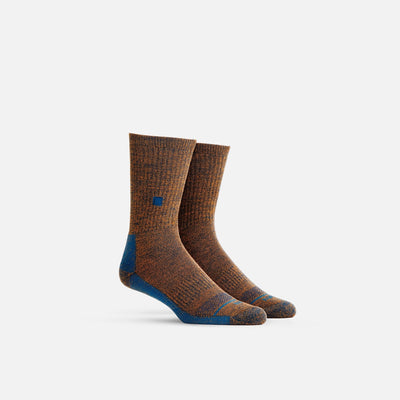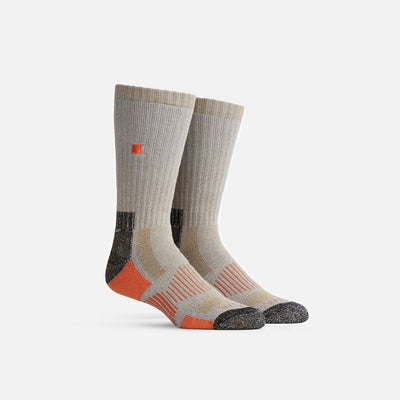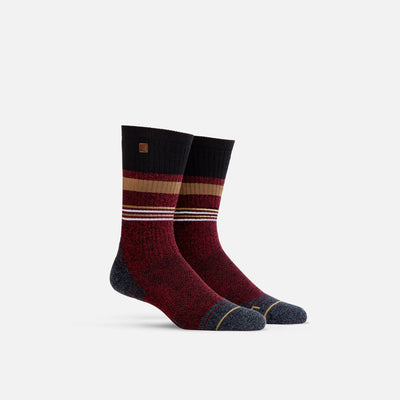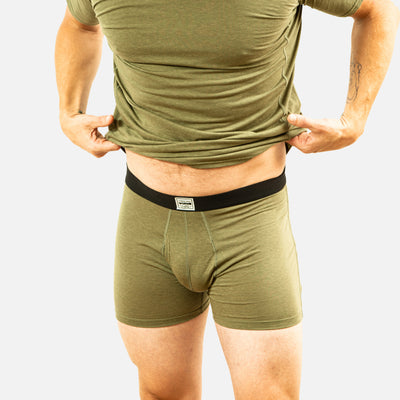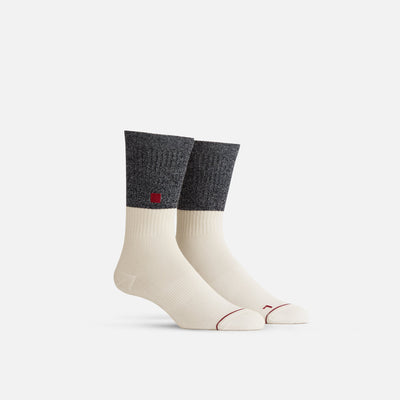Is Cotton Fabric Sustainable?

Choose a drawer from your dresser, open it, and pull out a random article of clothing. Right off the bat, there's a 50% chance what you're holding in your hand is made, at least in part, with cotton.
It's true: the World Wildlife Fund (WWF) says that "approximately half of all textiles are made of cotton." And if we talk specifically about everyday wear socks (which is kind of our thing), the percentage is likely much higher than that. Case in point: a search for "cotton socks" on Amazon yields 40,000 results, while "wool socks" yields just 6,000.
Given the prominence of cotton in textile production and specifically in fashion and apparel, it's worth asking, is cotton fabric sustainable?
Unfortunately — for both the environment and eco-conscious consumers — the answer is a hard No.
Measuring Sustainability
Before we dive into the specifics of cotton, let's define what we mean by "sustainable," and how such a trait is measured.
Whether or not something is sustainable is somewhat subjective, depending on the specific criteria used and an individual's (or organization's) threshold for how much negative impact is acceptable. The Environmental Protection Agency (EPA) suggests, "To pursue sustainability is to create and maintain the conditions under which humans and nature can exist in productive harmony to support present and future generations."
This is consistent with the definition of sustainable development established by the United Nations Brundtland Commission in 1987, stating that it "meets the needs of the present without compromising the ability of future generations to meet their own needs."
The actual measurement of sustainability is even more subjective, since different activities involve different processes, by-products, and opportunity costs, while also serving purposes that involve differing (and also subjective) levels of necessity.
Steve Cohen, a professor at the Climate School of Columbia University notes, "There are objective methods for measuring energy efficiency, sources of energy, waste production, effluents in water and emissions in the air. These can be combined into a set of generally accepted environmental sustainability metrics."
There are a number of international government organizations, NGOs, non-profits, and other businesses that focus on this topic, often providing industrial "green" certifications in addition to their peer reviewed scientific studies.
The Trusted Names In Green Certifications
There are a number of "household names" when it comes to certification for sustainable products. Some you may recognize include:
When it comes to sustainable farming and agriculture specifically, the most trusted certification organizations get a bit more specialized:
- Rainforest Alliance
- Ecocert
- Global Organic Textile Standard
- SGS International Sustainability and Carbon Certification
And on top of those, organizations such as BM Trada provide certification for the entire supply chain.
So, make no mistake. When it comes to sustainability in clothing, there are many resources available to the businesses every step of the way to ensure they are focused on the things that matter.
Now, let's take a look at cotton, specifically.
Just how big is the cotton industry?
For starters, consider this finding by the USDA:
In marketing year (MY) 2019—August 2019-July 2020—the United States produced nearly 20 million bales of cotton, representing about $7 billion in total (lint plus seed) value. Furthermore, the United States is the world's leading cotton exporter, providing approximately 35 percent of global cotton exports in recent years.
[source: USDA.gov]
Massive numbers — and that's just the U.S. It’s also grown and processed in China, India, Australia, Argentina, Uzbekistan, West African countries, and other areas.
Want to know how much land this requires? In the U.S. in 2019, the total harvested land area for cotton was estimated at 11.4 millions acres by the USDA. That means you could almost cover the entire state of West Virginia with cotton. Put another way, about one out of every 200 acres of land in the U.S. is covered with cotton. And again, this doesn't even count the land use in other countries.
Textile Exchange, a nonprofit organization, determined in a 2019 study of global fiber production that "cotton is the second most important fiber [behind polyester] in terms of volume," making up nearly a quarter of all global fiber production.
Furthermore, the WWF estimated in 2014 there are 300 million people around the world (many in developing countries) who rely on the cotton industry for income.
So, yes... cotton is big. It's huge. And, sadly, it's hurting our environment.
What Kinds of Products Use Cotton?
In addition to the heavy use of cotton in apparel, it is also used in the manufacture of many other textiles and common products, such as bed sheets, hand bags, paper products, feminine hygiene products, coffee filters, and a wide variety of other items.
Oil from cottonseeds is used in many foods and cosmetic products. And cotton seeds themselves are used as an ingredient in many varieties of animal feed.
See more uses of cotton in our 10 Facts You Didn't Know About Cotton article.
It's true that cotton is a versatile crop with many practical applications, but there are serious costs to consider with the amount of cotton needed for all of its uses.

The Cotton Agriculture Process
Let's look at how cotton is actually grown, harvested, and processed.
Cotton Farming
As noted above, the amount of farmland cotton currently covers is quite vast. However, that in itself is not a problem. It's only logical that the most in-demand crops require the most land to meet that demand. The problem starts with the fact that the demand is so high that many farmers have to use the same land every year to grow it, which depletes the soil of nutrients and makes long term sustainability difficult.
Another problem with cotton farming has to do with its disproportionate needs (relative to other crops) for keeping it healthy and productive. For instance, the cotton plant requires heavy irrigation to flourish and many areas don’t have enough rainfall to produce healthy crops. So, farmers are forced to irrigate using well water or water from nearby rivers.
According to the Organic Trade Association (OTA), a conventional cotton t-shirt takes 2,700 liters of water to make, and a pair of jeans takes almost 11,000.
Are you someone who takes short showers? The average American shower uses 65.1 liters of water. That's almost 200 showers to use the same amount of water consumption to produce one cotton t-shirt! If you're the short shower type, you might stay clean for a full year for the water cost of that shirt.
Cotton also typically requires the use of pesticides and insecticides, particularly when the plant is young and more susceptible to pests. And that same OTA report cites that "in the U.S., approximately 48 million pounds of pesticides were used on approximately 12.6 million acres of cotton planted in nine states in 2017 ... amounting to an approximate average of 3.8 pounds of pesticides per acre of cotton grown."
Cotton Harvesting
Cotton is harvested through a combination of manual and mechanical processes, often varying based on the size of the farm and its location in the world. High volume commercial farms might use heavy machinery to collect the cotton from the plant and strip it from its shell. Lower volume farms, and those in developing countries, often have more manual labor in these stages.
Whether you're looking at the fuel and energy cost or the human cost (picking cotton is typically a very strenuous, very low wage job, and frequently linked to abusive conditions), there are serious concerns about getting the cotton from the plant to the processing line.
Cotton Production
Once the harvested cotton arrives at the production facility there are several steps to turn it from the raw material into a market-ready product. This energy-intensive process involves using a cotton gin to clean and separate the cotton, followed by bales of the cleaned cotton being sent to the next facility (depending on the buyer and what they intend to manufacture).
With textiles, there is again a huge amount of water involved in the process, as well as potentially dangerous chemicals and dyes, some of which can wind up in the water system or in the final product itself. A variety of such dangers are enumerated in this story by re/Make, an environmental advocacy group focused on ethical and sustainable fashion.
In addition, the Environment Justice Foundation (EJF) found in 2020 that global cotton production accounts for 220 million tons of CO2 emissions annually.
And Then There's the Waste Factor...
The issues with cotton don't end when the shirts, socks, and bags hit the store shelves. Cotton wears out quickly, and when it does, it finds its way to the landfill.
In fact, our own estimates suggest that with cotton socks alone, consumers are throwing out over 200,000 tons of socks every single year. If that number is hard to visualize, it boils down to 10 pairs of cotton socks per person, in the trash every year.
Oh, and not to overstate the matter, but when socks get thrown out — which, again, cotton socks frequently do — they need to be replaced. And for many people, that has meant more cotton and starting the whole process over again.
We’re hoping to break this “double-whammy” cycle of short-lived products generating literal tons of waste.
The Best Cotton Products
We're not here just to rag on cotton all day (pun intended). It certainly is a useful and convenient material and there are plenty of cases where it makes sense to manufacture with cotton.
Cotton products are great when other materials would be less suited to the application and the environmental impact is minimized. For example, consider an organic cotton sweatshirt. There are a few main things working in favor of this type of product:
- Organic cotton, while more expensive to produce, generally minimizes or eliminates pesticides and other harmful chemicals from it's farming process, and its growers may also focus on conserving water usage as much as possible.
- As a sweatshirt, the fabric is unlikely to be exposed to excessive friction or stretching, giving it a longer expected life. On a large scale, this reduces waste (when was the last time you threw a sweatshirt in the trash?) and thus moderates the need for additional production.
- Sweatshirts, as opposed to many other articles of clothing or other cotton products, make great hand-me-downs or clothing donations. A single sweatshirt, treated with the proper care, might survive for 10 or 20 years, even if it travels between owners.
If you consider these three factors, you can get an idea of how any cotton product might rate as far as the necessity of the material.
To contrast, cotton socks don't really pass any of these tests.
It's possible to find 100% organic cotton socks, but they're not particularly common. Less than 1% of all cotton textiles are 100% organic.
As far as friction and stretching, you don't have to be a marathon runner to give your socks a workout. Everyone who's ever worn cotton socks on a daily basis knows that it doesn't take much to develop that first hole, usually at the places where your foot makes the most contact with the ground.
And donations? We're all for donating clean, fresh socks. And while disadvantaged folks don't always have a say in what condition their clothes come in, it's safe to say that many articles of clothing make better second-hand items than socks.

Sustainable Wool Production
We've done a lot of talking about cotton here, but none of it means anything if there are no sustainable (and practical) cotton alternatives.
Enter: Wool.
Fine, maybe wool isn't perfect for every occasion, but we live in the sock world, and it sure is a perfect solution here. Durable, comfortable, affordable, sustainable.
A Quick Look at Wool Farming
Unlike cotton, wool is not a crop. It comes right from the sheep* with little more than electric shears required for harvesting. Of course, raising and caring for the sheep does require a fair bit of work and hardware.
*Other animals, such as alpacas and llamas, also produce wool fiber, but for this article we're focused specifically on sheep, which represent a vast majority of all wool production.
Renewable Resource
You probably already knew this, but wool is a renewable resource, meaning it can be harvested and used without depleting the supply. In other words, the sheep grow the wool back by the following year.
If you're wondering if the shearing of the wool causes any pain or health risks to the sheep, you'll be pleased to know it's a very safe, painless procedure. If you've ever used an electric trimmer to cut someone's hair, it's a similar process.
The wool is grown as a source of warmth for the sheep and protection from the elements. As long as the sheep have other means of protecting themselves (namely, a stable or other type of shelter), they're just as warm and safe as they would be with their wool.
Learn more about wool in out Wool Myths: Setting the Record Straight article.
Ranking Textile Materials on Sustainability
To again reference the Textile Exchange report, there are some other types of fibers that are used in textiles. In order of prevalence, here's how each one ranks:
- Polyester (51.5% of all fiber production in 2018)
- Cotton (24.4%)
- Manmade Cellulosics Fibers (MMCFs) (6.2%)
- Other synthetic materials (5.7%)
- Other plant-based materials, such as jute, linen, and hemp (5.7%)
- Polyamide (~5%)
- Wool (~1%)
- Down (~0.3%)
- Silk (~0.1%)
As you'll note, there are a number of synthetic materials on the list, none of which are particularly environmentally-friendly. Polyester was the dominant one, comprising over 50% of all fiber production. Also on the list is polyamide (aka nylon). The "other synthetic materials" include a variety of lesser-known fibers being developed by different manufacturers.
There are many ways to analyze the environmental cost of each of these textiles, and most experts would agree that the artificial fibers are more destructive than their natural counterparts. Polyester, for example, involves fossil fuels and harmful emissions into the atmosphere.
MMCFs comprise a variety of materials, such as acetate and viscose, that are manufactured primarily from wood pulp. As such, there are significant concerns here as it comes to deforestation.
Some of the other natural fibers, such as jute and hemp, are interesting because their environmental impact is relatively low, and they can be quite durable. Unfortunately, when it comes to clothing, they lack a necessary level of comfort to be viable in the marketplace, unless they're blended with some synthetics, which, well... you get it.
Conclusion
As much as we may love our jeans, our favorite t-shirt, and that one worn out pair of tube socks with the colored stripes, the fact is that cotton is not a sustainable fabric at its current production volume.
If the statistics above didn't convince you, here's one more. The Carbon Disclosure Project (CDP), a global not-for-profit, launched its Water Impact Index in August 2021. This index scores each of 200+ industrial activities on their impact on water resources (quality and quantity).
Cotton farming was one of just eight activities given a rank of 18, the highest (read: worst) overall, and equating to a rather condemning "Critical" impact on water resources. Note that two of the other "Critical" activities are Textiles (in general) and specifically Apparel design & manufacturing. When you account for the prevalence of cotton in the textile industry, it's clear that cotton is dragging down the scores of these activities it factors into so heavily.
Worn chooses to keep our products 100% cotton-free, and we hope we can count on you to make the same choice whenever you can.


